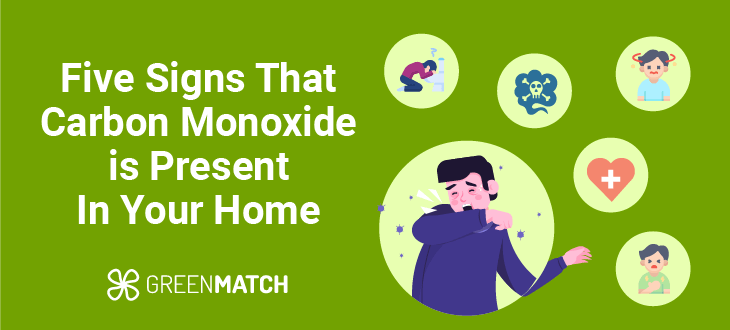- GreenMatch
- Blog
- Five Signs That Carbon Monoxide is Present In Your Home
Five Signs That Carbon Monoxide is Present In Your Home


In UK homes, boilers are essential. However, they can also become a major danger due to carbon monoxide. Known as the 'silent killer’, this fatal, odourless, and colourless gas is produced when fuels don’t burn completely, disrupting the body’s process to get oxygen, and causing sickness that on extreme occasions can even lead to death.
Due to a lack of precaution towards CO production in the UK, approximately 60 people lose their lives annually and roughly 4,000 end up hospitalized. Therefore, regular boiler maintenance is crucial for its efficiency and your own safety. It can prevent the need for costly repairs, provide efficiency, and protect your home against CO leaks, making it a necessary safety measure.
For that reason, Carmen Mata Castillo, Boiler Expert at GreenMatch, has revealed five signs that indicate carbon monoxide is present in your home.
1: Health symptoms
Carbon monoxide poisoning typically presents flu-like symptoms, which are often misidentified. A family member, even pets, who are exposed to CO at home, can experience headaches, fatigue, nausea, dizziness, and other feelings of unwellness. The most characteristic feature that makes such symptoms distinctive from a normal flu, is their pattern. If you're experiencing them, they tend to improve when you leave the house. However, once back, the symptoms return.
Over time, ongoing exposure to CO may result in even more serious symptoms, including confusion, chest pain, and loss of consciousness. One should be aware of these health risks during the whole year, particularly in spaces with heating or hot water running.
2: Pilot light issues
Your boiler’s pilot light should produce a continuous blue flame if functioning properly. However, if the light is flickering, it could signify a malfunction with your boiler. If it’s constantly going out or struggling to stay lit, it’s a strong indication of problems that potentially involve carbon monoxide. This problem can be caused by a lack of oxygen during the combustion process, a defective thermocouple, or a plugged gas line, all of which can result in CO production.
If you choose to ignore this matter, it will not only negatively affect your boiler and its performance, but also increase the exposure to harmful gas leakage.
3: Yellow or brown stains
Yellow, brown, or black spots around your boiler or other gas appliances, are clear visual warning signs, which indicate the presence of carbon monoxide. These types of stains are typically smoke deposits often arising as a consequence of the incomplete combustion of fuel. Be particularly aware of streaks or stains on walls, ceilings, or surfaces within close proximity to the boiler. These marks tend to become more noticeable with time; therefore, regular check-ups of the surrounding area of your boiler are worth it.
4: Excessive condensation
Augmented condensation, especially around your boiler and on objects nearby, like windows, walls, or ceilings, is an important yet critical sign of carbon monoxide presence. Excessive water consumption is normally the consequence of improper combustion in one’s boiler. You might observe foggy or cloudy spots around objects inside your home, especially in the same room where your boiler is located.
This condensation can be more intense than indoor humidity and may be visible even when conditions wouldn’t usually cause it. In certain cases of corrosion, you may even notice water droplets forming on cold surfaces or running down your walls. Although it’s fairly usual for condensation to accumulate around high-efficiency heating facilities, uncommon patterns of moisture need to be checked out. These unusual patterns could be a sign of improper unleashing, or combustion problems that can lead to CO production.
5: Carbon monoxide detection alarms
If you don’t own a carbon monoxide detector, it’s highly recommended to install one on every level of your property, especially close to sleeping areas and fuel-burning devices. If the alarm goes off, it will indicate an evident sign of dangerous CO levels in your household. This would require immediate actions: you must open your windows to ventilate, turn off your boiler, and evacuate your home. Once safe, contact a Gas Safe registered engineer to perform an inspection.
Given that CO is colourless and odourless, owning alarm detectors will ensure you have the best defence against it. According to research, 37% of homes in Northern England have a working CO alarm, and only 24% frequently test it. This lack of care leaves many homes vulnerable to this invisible threat. Therefore, it’s essential to frequently test and keep maintenance of these alarms, in order to make sure they function correctly.
Carmen Mata Castillo, Boiler Expert at GreenMatch:
“Like other appliances, boilers are susceptible to leaks, and the most dangerous byproduct is carbon monoxide. Since it is released undetected, it gives rise to serious health risks to families. Therefore, it's essential to keep in mind the need to strategically install carbon monoxide alarms around your home and stay vigilant for warning signs, from health symptoms to pilot light issues.
Moreover, routine maintenance is necessary in order to keep your household safe from this invisible and threatening ‘silent killer’.”

Carmen is a writer at GreenMatch who has a strong interest in renewable energy and finds purpose in educating others on sustainable practices that will help create a more environmentally friendly future. Her attention to detail and dedication to accuracy ensure that every piece is reliable and helpful.
We strive to connect our customers with the right product and supplier. Would you like to be part of GreenMatch?

